Brand Style Guide Template: Create Professional Branding Guidelines in 2025
Written by David L Hicks – June 16th, 2025
Maintaining a consistent brand presentation across all platforms can significantly enhance your organization’s presence. Whether you’re a startup founder, designer, or marketing professional, having a comprehensive brand style guide is essential for maintaining consistency across all your brand touchpoints.
Unfortunately, creating one from scratch can feel overwhelming for you and your organization. Questions like where do you start? What elements should you include, and how do you ensure nothing gets missed that can cause you frustration? That’s why this article defines a brand style guide, its essential requirements, and what goes into choosing the right style guide. This guide also presents the 10 best brand style templates. Read through this article, you’ll be well on your way to having an excellent brand style guide template for your brand’s organization.
Table of Contents
ToggleWhat is a Brand Style Guide Template and Why You Need One
Before jumping into developing your style guide, it’s essential to understand what a brand style guide template is.
Definition of Brand Style Guide Templates
A brand style guide template is your brand’s rulebook; it’s a pre-formatted document that outlines how your visual identity should be used across all marketing materials and touchpoints. Your brand is essential; the look and design help give customers an understanding of who you are. This template plays a similar role to your content strategy template and content brief template. They help define and guide your strategy.
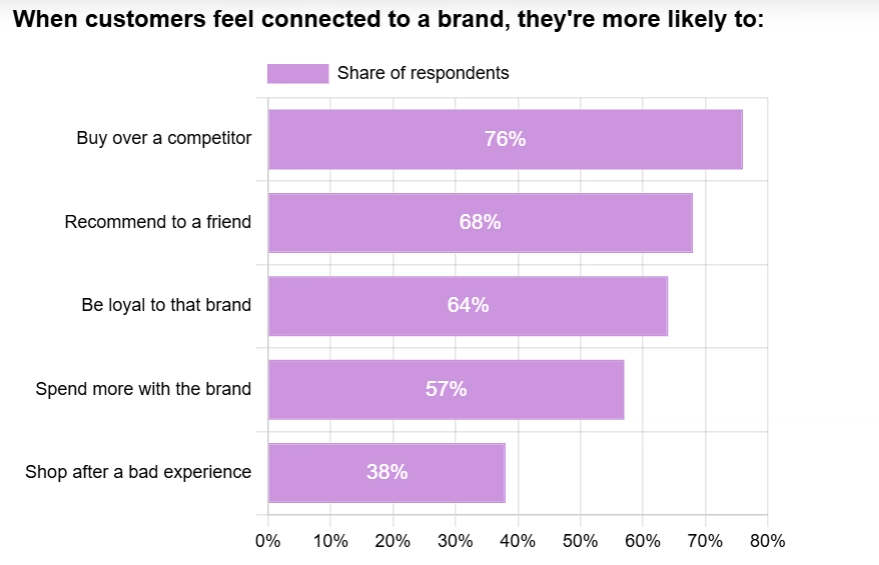
(Source – Digital Silk)
It’s essential to consider how you want your brand to appear. Your template should include sections for logo usage, color specifications, typography choices, and tone of voice guidelines. Without this foundation, your brand messaging gets diluted faster than you’d expect.
Benefits of Using Templates vs. Creating from Scratch
Creating your template from scratch can be a frustrating and daunting task. It can be easy to overlook key items, such as social media specifications or print guidelines. There is also a significant amount of setup time required when developing a custom template.
Leveraging professional templates is a more sound option. This is for a couple of different reasons, including:
- Professional templates follow industry best practices.
- Professional templates are tested across thousands of brands.
- Professional templates save your organization time and allow them to focus on other tasks.
With the implementation of a template, you’re not reinventing the wheel, which means fewer mistakes and better results.
How Style Guides Ensure Brand Consistency Across Teams and Platforms
Style guides act as your quality control system. When your social media manager, web designer, and print vendor all follow the same guidelines, it makes ensuring brand consistency much easier. Every touchpoint reinforces your brand identity rather than working against it.
Cost Savings and Time Efficiency of Template-Based Approach
Templates typically cost between $5 and $150, while hiring a designer to create custom brand guidelines on the high end runs about $2,000 to $5,000. The math is pretty straightforward there.
More importantly, templates speed up your onboarding process. New team members can reference the guide immediately, eliminating the need to guess or ask endless questions about brand standards.
Essential Elements Every Brand Style Guide Template Must Include
Many elements go into a brand style guide template. Below is a list of the essential items to look for if you’re developing your own or purchasing one.
Logo Usage Guidelines and Variations
Your logo is your most valuable brand asset, so protecting it appropriately is crucial. It’s important to include at least two logo variations in every style guide: a primary and a secondary version. For example, consider sports team logos, particularly those of the NFL. They traditionally have two logos: the primary logo and the wordmark logo. The examples below display the primary logos and wordmark logos for the Buffalo Bills and Kansas City Chiefs sports teams.

(Source – NFL)
Primary logos traditionally get used on main marketing materials. Secondary versions, such as the wordmark logo, are suitable for smaller applications, like social media avatars.
It’s important not to forget to specify your minimum size requirements. It is typically recommended that print materials be at least 1 inch wide. Clear space guidelines are equally important; usually, 1.5x the logo height on all sides prevents cramped layouts.
Color Palette Specifications
Color palette specifications are extremely important to the development of your style guide. Unfortunately, many companies select colors but fail to document the exact codes. This causes a lack of consistency across your brand’s marketing. Your style guide should include consistent hex codes for web use, RGB values for digital screens, CMYK values for print, and Pantone numbers for professional printing.
Try limiting your primary palette to 3-5 colors maximum. Too many options create decision paralysis and inconsistent applications. Ensure that you include both primary and secondary color options, as well as neutral tones for backgrounds and text. It’s essential to always test your colors across different mediums. What looks great on your computer screen might print terribly.
Typography Hierarchy and Font Selection Guidelines
Having a typography hierarchy prevents messy, amateur-looking design that screams, “We don’t have our act together.” Try structuring your typography hierarchy with primary fonts for headings, secondary fonts for body text, and sometimes a third accent font for special applications.
Photography and Imagery Style Requirements
Visual consistency extends way beyond your logo. The style and how your images are captured go a long way in explaining your brand. To capture your brand’s photography style effectively, it’s essential to document it.
Your photography descriptors may include the following:
- Bright
- Vibrant
- Airy
- Moody
- Dark
- Clean
- Minimal
Be sure to include specific requirements, such as lighting preferences, color treatments, and subject matter guidelines, as well.
To gain a better understanding of what you want your brand’s imagery to look like, consider browsing various websites and stock photos that inspire you.
Voice and Tone Documentation
Your brand voice is how you sound across all communications; it doesn’t matter if it’s formal, casual, playful, or authoritative. Create tone variations for different situations. Your social media tone might be more casual than your press releases. Document these differences clearly so that your team knows when to make adjustments.
Include a list of preferred terminology and words to avoid. For example, if you’re a tech company, decide whether you’ll use “customers” or “users” consistently throughout all materials.
Spacing, Layout, and Grid System Specifications
Good spacing makes the difference between professional and amateur design. It’s vital to document your exact measurements for margins, padding, and element spacing. Whether it’s a 12-column web grid or a simple 3-column print layout, document it clearly with visual examples.
Also, don’t forget to include guidelines for white space usage as well. Cramped designs appear desperate, while proper spacing creates a premium, trustworthy feel that customers respond to.
How to Choose the Right Brand Style Guide Template for Your Business
Choosing what you want your brand to be and look like is extremely important and can be a difficult task. Luckily for you, it doesn’t have to be that way; to choose the right brand style for you, follow the steps below.
Assessing Your Brand’s Complexity and Needs
It is crucial to understand the complexity and needs of your brand. To do so, start by evaluating how many touchpoints your brand has. For example, a local bakery needs different guidelines than a SaaS company that offers multiple product lines.
Businesses that have a single-focused offering might only need logo, color, and font specifications. Complex organizations with multiple offerings require sub-brand guidelines, co-branding rules, and detailed application examples across dozens of materials. Organizations with multiple business units may also require their own logos and color scheme variations. Another thing to take into account is your team size.
Industry-Specific Considerations and Requirements
Healthcare brands need accessibility compliance built into their templates – things like color contrast ratios and readable font sizes. In contrast, financial services generally require professional, trustworthy design elements that convey stability. Tech companies often need dark mode specifications and mobile-first guidelines. Restaurants benefit from adhering to food photography standards and packaging design guidelines. Always keep in mind your industry dictates which sections matter most in your style guide.
Budget Considerations for Free vs. Premium Templates
Free templates are an excellent option for solopreneurs, startups, and small businesses just getting organized. It’s also great for any organization on a budget. Premium templates, on the other hand, are ideal for organizations that have a clear understanding of their identity and goals.
Premium templates feature advanced elements, including interactive components, collaboration tools, and industry-specific sections. They’re worth it if you’re managing multiple team members or need professional polish.
Scalability Factors for Growing Businesses
When selecting a template, whether free or premium, ensure that you choose one that can grow with your business. You don’t want to frantically scramble to rebuild everything after you’ve quickly outgrown your basic templates.
Look for templates with expansion sections for sub-brands, product lines, or international markets. Modular designs let you add components without starting over from scratch.
Best Places to Build Your Templates
If you decide to build your own templates, there are a couple of great places you can go. For those who choose to use an existing template, some of them also offer free templates.
1. Canva

Canva is a fantastic graphic design tool. The Canva platform offers an extensive list of features, including the following:
- Magic Studio – Offers AI-powered design capabilities that help with designer productivity.
- AI Background Generator – Offers the ability to create backgrounds for photos and scenes.
- Collaboration tools – Offers users real-time editing and commenting features.
- Templates – Offers users documents, presentation infographics, and other types of templates.
Canva’s free templates include sections for logo variations, color palettes, and font combinations, everything you need for basic brand consistency.
The customization that Canva offers is extensive. You can upload your own fonts, create custom color palettes with hex codes, and even set up brand templates for your team to use.
2. Adobe Creative Cloud

Adobe’s Creative Cloud Libraries offer some fantastic brand guide templates, especially if you’re already in their ecosystem. The templates integrate seamlessly with Photoshop, Illustrator, and InDesign.
Their brand guideline templates are more comprehensive than most free options. You get detailed sections for logo usage, typography scales, and even packaging guidelines if needed.
3. Figma
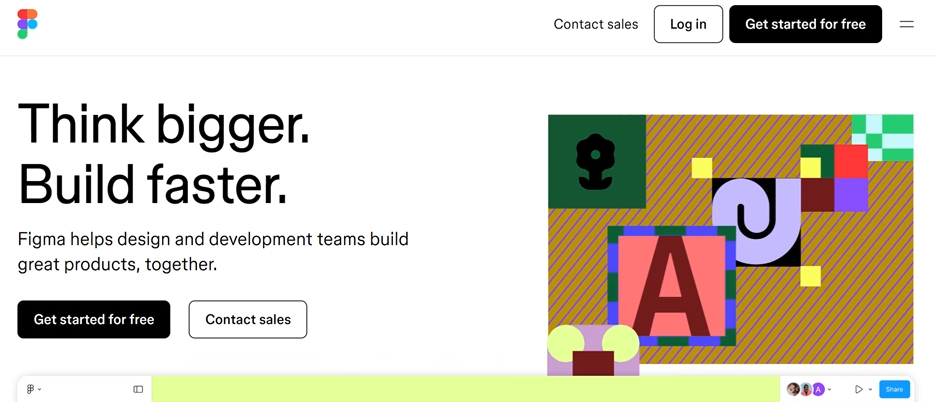
Figma’s community section is a goldmine for brand style guide templates, and many are completely free. The collaborative editing features make Figma templates perfect for remote teams. Multiple people can work on the same brand guide simultaneously without version control nightmares.
4. Google Slides
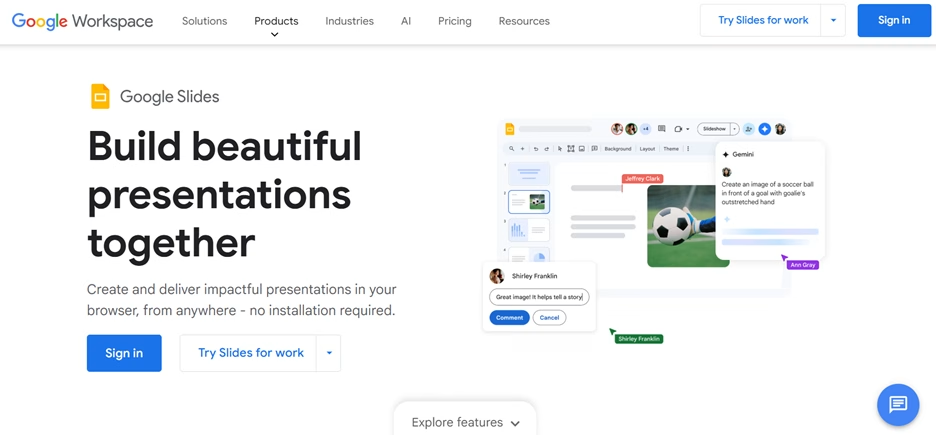
Don’t ignore presentation software. From a brand guide standpoint, they’re actually perfect for this purpose. Google Slides offers several free brand guideline templates that are surprisingly comprehensive. They offer easy-to-design presentation slides and real-time collaboration. Their real-time collaboration prevents those annoying “who has the latest version?” problems.
5. Microsoft PowerPoint

Most people and organizations alike have PowerPoint. It’s arguably the best option because it’s the most easily accessible. Everyone knows how to use PowerPoint, so your team can reference and update guidelines without learning new software.
PowerPoint’s design ideas feature suggests layouts based on your content, which speeds up the customization process significantly.
Best Free Brand Style Guide Templates Available in 2025
1. Minimal and Modern Digital Brand Guidelines Template

This brand guideline template is designed for use in InDesign and includes six design options. The Minimal and Modern Digital Brand’s design is versatile, making it ideal for small and mid-sized organizations, solopreneurs, and large companies alike.
2. Black and Brown Minimalist Modern Brand Guidelines Template
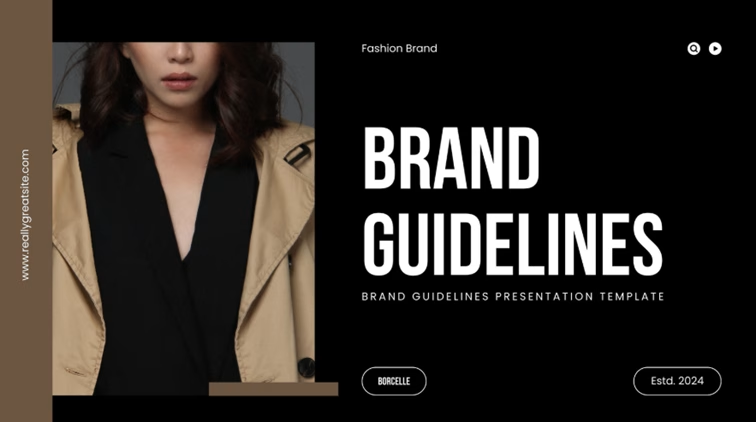
This Canva-based brand style guideline has a modern look, which works great for fashion and style-centric brands. The brown and black with white wording is a combination not often used, making it a unique choice if selected. It’s also customizable for anyone who wants to add their own spin to the design.
3. Tech and Gaming Guidelines Template

This futuristic-looking brand guideline is aimed at gaming but is also great for tech-based organizations. The black and bright red-white lettering is popular among many tech companies, such as Falcon. The Tech and Gaming template is customizable via Canva.
4. Green and White Brand Guidelines Template

Another Canva-based guideline template. The green, white, and gold give this template a clean look. This template is also customizable.
5. Black and Green Guidelines Template
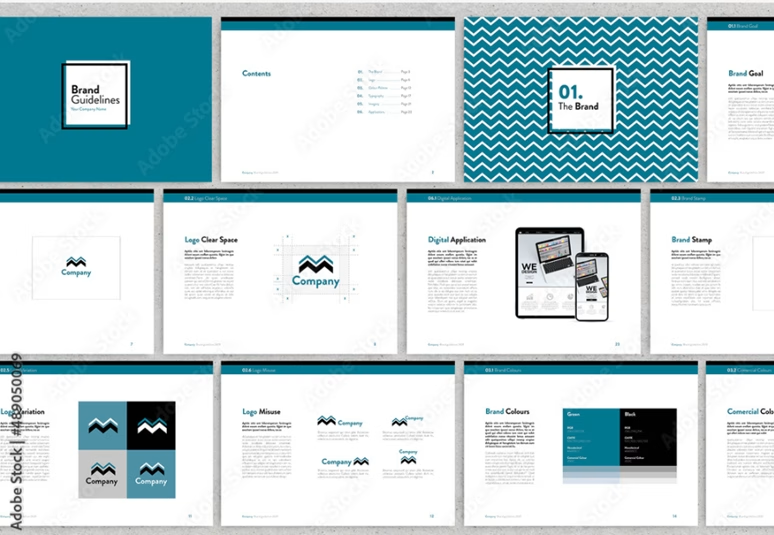
The Black and Green template is unique among other templates. It offers a unique visual with its crooked lines and teal/green. The color scheme of teal/green, black, white, and gray gives this template a pop.
Best Paid Brand Style Guide Templates Available in 2025
1. Mooco Brand Guidelines Template

This stylish brand template features a classic look with a color palette of red, white, and black. The Mooco Brand guidelines feature a master slide layout, drag-and-drop photo replacement, and 37 unique slides. This template is compatible with Adobe InDesign and Canva.
2. Brand Identity Guidelines Template

The Brand Identity template is a sleek template featuring an engaging color scheme. The various colors, including green, white, and orange, complement each other well and balance each other out. The Brand Identity guideline template comes with 30 layouts that are fully editable. This template is compatible with Adobe InDesign and Canva.
3. Hilma Brand Guidelines Template
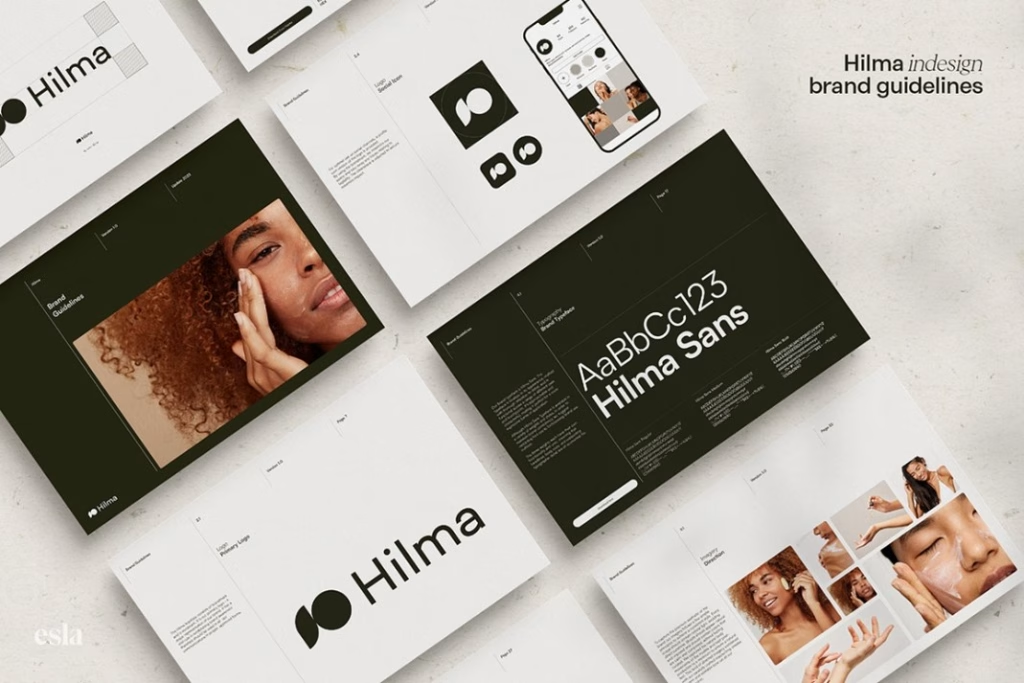
Hilma Brand template has a very traditional look with its black and white color scheme. This makes it ideal for any organization starting out. The use of black and white as its two primary colors makes it easy for any organization to get started with launching their brand design. The template comes with iPhone, iPad, Instagram, and Stationery Vector Mockups and is compatible with Adobe InDesign.
4. Royal Brand Guidelines Template
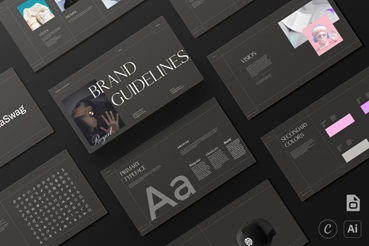
Royal Brand offers a cool template that focuses predominantly on dark colors, featuring black and gray. The white and pink allow a bit of contrast to the dark tones. Royal Brand is compatible with Adobe Illustrator, Canva, and Google Slides.
5. Brand Guidelines Template
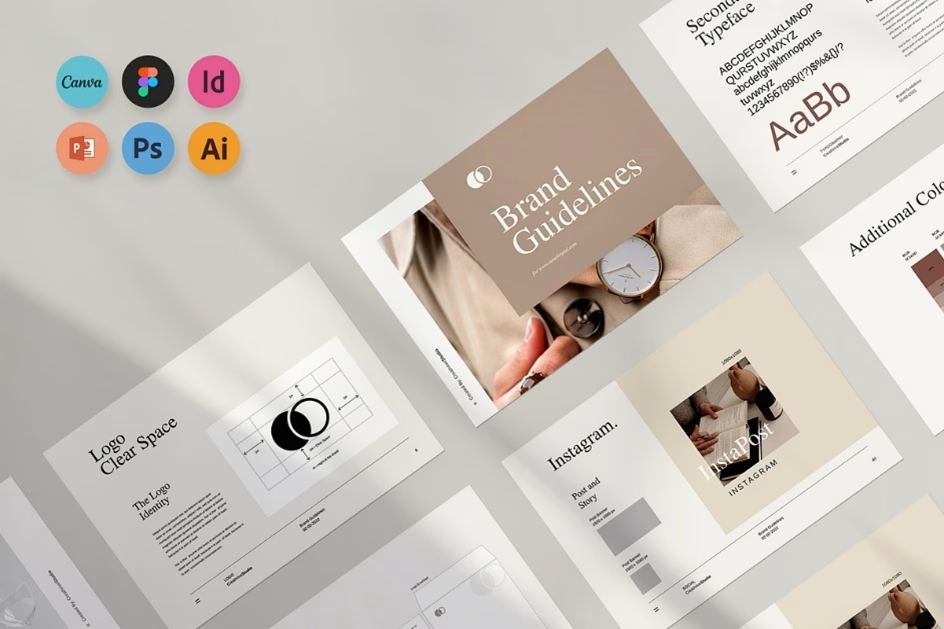
This Brand template is the perfect contrast to Royal Brand. The Brand’s template focuses on light colors, including white, light gray, and light brown/beige. The template is compatible with the following tools: Figma, Canva, Adobe InDesign, Microsoft PowerPoint (part of Microsoft Office), Adobe Photoshop 2019, and Adobe Illustrator 2019.
Conclusion
Creating a professional brand style guide doesn’t have to be a daunting task, especially if you start with the right template. By following the strategies outlined in this guide, you’ll have everything you need to build a comprehensive brand identity system that keeps your business looking polished and professional across every touchpoint.
Remember, consistency is key, and the correct template makes achieving that consistency both scalable and straightforward. If you’re ready to get started, try leveraging one of the places to build your own template or try one of the free or paid templates listed in this article. Your future marketing campaigns (and your design team) will thank you.